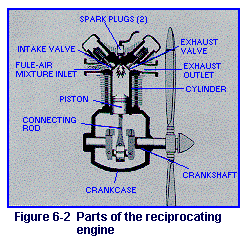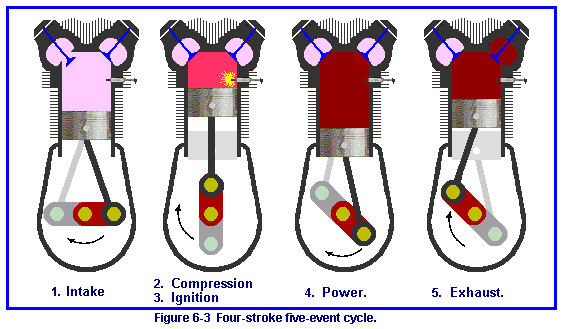 |
|||||
| Home | Research | For Teachers | HISTORY Level 1 Level 2 Level 3 |
PRINCIPLES Level 1 Level 2 Level 3 |
CAREER Level 1 Level 2 Level 3 |
| Gallery | Hot Links | What's New! | |||
| Web Administration and Tools | |||||
 |
|||||
| Home | Research | For Teachers | HISTORY Level 1 Level 2 Level 3 |
PRINCIPLES Level 1 Level 2 Level 3 |
CAREER Level 1 Level 2 Level 3 |
| Gallery | Hot Links | What's New! | |||
| Web Administration and Tools | |||||
![]()
The reciprocating engine is also known as an internal-combustion
engine. This name is used because the fuel mixture is burned within the engine. To
understand how a reciprocating engine works, we must first study its parts and the
functions they perform.

(1) The cylinders
(2) The pistons
(3) The connecting rods
(4) The crankshaft
(5) The valves
(6) The spark plugs
(7) A valve operating mechanism (cam).
Refer to the relative location of these parts in Figure 6-2 .
The cylinder is closed on one end (the cylinder head), and the piston
fits snugly in the cylinder. The piston wall is grooved to accommodate rings which fit
tightly against the cylinder wall and help seal the cylinder's open end so that gases
cannot escape from the combustion chamber. The combustion chamber is the area between the
top of the piston and the head of the cylinder when the piston is at its uppermost point
of travel.
The up-and-down movement of the piston is converted to rotary motion to
turn the propeller by the connecting rod and the crankshaft, just as in most automobiles.
Note the crankshaft, connecting rod, and piston arrangement in Figure 6- and imagine how
the movement of the piston is converted to the rotary motion of the crankshaft. Note
particularly how the connecting rod is joined to the crankshaft in an offset manner.
The valves at the top of the cylinder open and close to let in a mixture
of fuel and air and to let out, or exhaust, burned gases from the combustion chamber. The
opening and closing of a valve are done by a cam geared to the crankshaft. This gearing
arrangement ensures that the two valves open and close at the proper times.
Now let's consider the movement of the piston (four strokes) and the five events of a
cycle (see figure 6-3 ).

To see the animation 6-3 press here. ![]()
The cycle begins with the piston at top center; as the crankshaft pulls the piston downward, a partial vacuum is created in the cylinder chamber. The cam arrangement has opened the intake valve, and the vacuum causes a mixture of fuel and air to be drawn into the cylinder.
As the crankshaft drives the piston upward in the cylinder, the fuel and air mixture is compressed. The intake valve has closed, of course, as this upward stroke begins. As the compression stroke is completed and just before the piston reaches its top position, the compressed mixture is ignited by the spark plug.
The very hot gases expand with tremendous force, driving the piston down and turning the crankshaft. The valves are closed during this stroke also.
On the second upward (or outward, according to the direction the unit
is pointed) stroke, the exhaust valve is opened and the burned gases are forced out by the
piston.
At the moment the piston completes the exhaust stroke, the cycle is
started again by the intake stroke. Each piston within the engine must make four strokes
to complete one cycle, and this complete cycle occurs hundreds of times per minute as the
engine runs.
The overall principles of reciprocating-engine operation are easy to understand if you remember what happens with each stroke that the piston makes. For this reason, you may find the chart in Table 6-3 helpful.
| Table 6-3 | ||
| Direction of Movement | Event (what happens) | |
| 1. | Inward (Down) | Intake |
| 2. | Outward (Up) | Compression and Ignition |
| 3. | Inward (Down) | Power |
| 4. | Outward (Up) | Exhaust |
Most persons are acquainted with the term horsepower as
applied to automobile and aircraft reciprocating engines. The term was coined by James
Watt, the inventor of the steam engine, who wished to evaluate the power output of his
steam engine. Watt hitched a horse to an apparatus and determined that the horse could
lift 550 pounds one foot in one second. Thus, one horsepower became the power to lift
550 pounds one foot per second, or 33,000 foot-pounds per minute (550 x 60).
If an aircraft reciprocating engine is rated at 150 horsepower, it means
the engine is capable of producing this much power. However, the engine has to be running
at a certain speed before that much power is produced. The same is true for all other
types of reciprocating engines.
Send all comments to ![]() aeromaster@eng.fiu.edu
aeromaster@eng.fiu.edu
© 1995-98 ALLSTAR Network. All rights reserved worldwide.
| Funded in part by | From Civil Air Patrol Educational Materials |
Updated: February 23, 1999